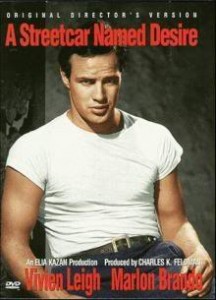A Streetcar Named Desire by Tennessee Williams
A Streetcar Named Desire (1951) is a subversive, steamy film classic that was adapted from Tennessee Williams’ 1947 Pulitzer Prize-winning play (his first) of the same name. [Early working titles for the play included The Moth, Blanche’s Chair on the Moon, and The Poker Night.] Playwright Williams adapted his own play for the screen version. This film masterpiece was directed by independent director Elia Kazan (his first piece of work with Williams), a socially-conscious director who insisted that the film be true to the play (that he had also directed on Broadway). However, it was opened up to include places only briefly mentioned or non-existent in the play, such as the bowling alley, the pier of a dance casino, and the machine factory.
The electrifying film tells the feverish story of the pathetic mental and emotional demise of a determined, yet fragile, repressed and delicate Southern lady (Blanche) born to a once-wealthy family of Mississippi planters. Her impoverished, tragic downfall in the squalid, cramped and tawdry French Quarter one-bedroom apartment of her married sister (Stella) and animalistic brother-in-law (Stanley) is at the hands of savage, brutal forces in modern society. In her search for refuge, she finds that her sister lives (approvingly) with drunkenness, violence, lust, and ignorance.
streetcar.jpg picture by lstlight
The visceral film, considered controversial, decadent, and “morally repugnant” challenged the regulatory Production Code’s censors (and the Legion of Decency) with its bold adult drama and sexual subjects (insanity, rape, domestic violence, homosexuality, sexual obsession, and female promiscuity or nymphomania). Ultimately, it signaled the weakening of Hollywood censorship (and groups such as the Catholic Legion of Decency), although a number of scenes were excised, and new dialogue was written. And the Production Code insisted that Stanley be punished for the rape by the loss of his wife’s love at the film’s conclusion. In 1993, approximately three to five minutes of the censored scenes (i.e., specific references to Blanche’s homosexual – or bisexual young husband, her nymphomania, and Stanley’s rape of Blanche) were restored in an ‘original director’s version’ video re-release.
The three main character roles in the ensemble were played with remarkably triumphant performances, all from various stage play casts. One film poster provided a partial film synopsis and description of characters:
…When she got there, she met the brute Stan, and the side of New Orleans she hardly knew existed…Blanche, who wanted so much to stay a lady.
27 year-old Marlon Brando, in his second screen role (after his first appearance in Fred Zinnemann’s The Men (1950)) and recreating his 1947 Broadway role (it premiered on December 3, 1947), delivered an overpowering, memorable, and raw naturalistic performance (an example of Method acting that he learned at the Actors Studio in New York under Stella Adler) as a sexually-powerful, animalistic, brooding primal brute – Stanley Kowalski, Blanche’s brother-in-law [The role was first offered to John Garfield, who rejected it because he felt the role was inferior to the female lead role.]
Unstable, delusional, and vulnerable Southern belle heroine (and former English teacher) Blanche, sensitively portrayed by Vivien Leigh, who recreated her role from the London production of the play (directed by then-husband Laurence Olivier). [Vivien Leigh’s character was a logical extension from her Scarlett O’Hara role in Gone With The Wind (1939) – a post-Rhett Butler Southern belle exhibiting a patrician facade. She was also beginning to show signs of her own emerging manic-depressive, bipolar illness in playing the part, and only appeared in three more films: The Deep Blue Sea (1955), The Roman Spring of Mrs. Stone (1961), and Ship of Fools (1965). In the Broadway stage production, Jessica Tandy played the role of Blanche. The role was first offered to Olivia de Havilland.]
Kim Hunter as Blanche’s younger sister Stella (a role she originally played on Broadway) and Stanley’s wife – a pivotal role
The controversial film was nominated for a phenomenal twelve nominations and awarded four Oscars (an unprecedented three were in the acting categories): Best Actress for Vivien Leigh (her second Best Actress Oscar), and Best Supporting Awards to Kim Hunter and Karl Malden. This was the first time in Academy history that three acting awards were won by a single film (this feat was later repeated by Network (1976). In addition, the Best B/W Art Direction/Set Decoration was given to Richard Day and George James Hopkins for their naturalistically sordid sets. Remarkably, these other eight nominations were all defeated:
Tennessee Williams’ Best Screenplay nomination
Marlon Brando’s Best Actor nomination (his first of four consecutive Best Actor nominations, for Viva Zapata! (1952), Julius Caesar (1953), and On The Waterfront (1954) – the last mentioned film won Brando his first Oscar)
Elia Kazan’s Best Director nomination
Harry Stradling’s evocative Best B/W Cinematography nomination
Alex North’s Best Score nomination for the ultra-sultry, steamy score
Nathan Levinson’s Best Sound Recording nomination
Lucinda Ballard’s Best B/W Costume Design nomination
and its Best Picture nomination


Comments
A Streetcar Named Desire by Tennessee Williams — No Comments
HTML tags allowed in your comment: <a href="" title=""> <abbr title=""> <acronym title=""> <b> <blockquote cite=""> <cite> <code> <del datetime=""> <em> <i> <q cite=""> <s> <strike> <strong>